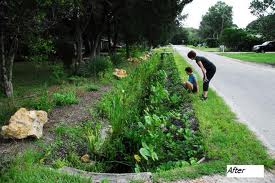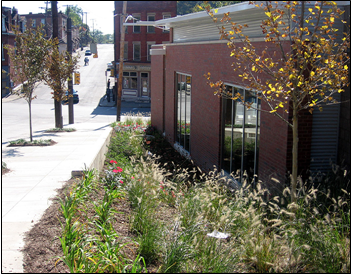

Bioswales are shallow, open channels that are designed to reduce runoff volume through infiltration. Additionally, bioswales trap trash and remove polllutants such as some chemicals by filtering water through vegetation and soil within the channel. Swales can serve as conveyance for stormwater and can be used in place of traditional curbs and gutters. The primary objective of a bioswale is infiltration and water quality enhancement rather than conveyance. However they can convey stormwater volumes to a discharge point, but unlike ditches, they intentionally promote the slowing and filtering of polluted runoff along the way. In addition to reducing the mass of pollutants in runoff, when properly maintained, bioswales can enhance the aesthetics of a site.
Bioswale vegetation is typically lawn grasses, but many low-volume swales are now being built with a combination of grasses, perennials, shrubs, groundcover and trees. A typical swale bottom is flat in cross section, 600 to 2400 mm wide, with a 1-2% longitudinal slope, or dished between weirs on steeper slopes. Bioswale side slopes are usually no more than 3:1, horizontal to vertical.
Bioswales are effective for removing

| Drainage Area | Soil Infiltration Rate | Water Table Separation | Depth to bedrock | Facility slope | Inflow rate |
| 2 ac | > 0.5 in/hr(if < 0.5 in/hr,install UD) | > 10 ft(if > 2 but < 10 ft,install UD) | > 10 ft(if > 2 but < 10 ft,install UD) | < 2% | Mulch: 1 cfs, Grass: 3 cfs |

| Task | Frequency | Maintenance Notes |
| Pruning | 1-2 times/yr | Nutrients in runoff often cause bioswale vegetation to flourish. |
| Mowing | 2-12 times/yr | Frequency depends on location and desired aesthetic appeal. |
| Mulching | 1-2 times/yr | Recommend maintaining 1"–3" uniform mulch layer. |
| Mulch removal | 1 time/2–3 years | Mulch accumulation reduces available water storage volume. Removal of mulch also increases surface infiltration rate of fill soil. |
| Watering | 1 time/2–3 days for first 1–2 months;Sporadically after establishment | |
| Fertilization | 1 time initially | One time spot fertilization for first year vegetation. |
| Remove and replace dead plants | 1 time/year | Within the first year, 10% of plants can die. Survival rates increase with time. |
| Inlet inspection | Once after first rain of the season, then monthly during the rainy season | Check for sediment accumulation to ensure that flow into the bioswale is as designed. Remove any accumulated sediment. |
| Outlet inspection | Once after first rain of the season, then monthly during the rainy season | Check for erosion at the outlet and remove any accumulated mulch or sediment. |
| Miscellaneous upkeep | 12 times/year | Tasks include trash collection, plant health, spot weeding, removing invasive species,and removing mulch from the overflow device |

| BMP | Retrofit ($/sq ft) | O&M ($/sq ft/yr) | Retrofit with Underdrain ($/sq ft) | New Construction ($/sq ft) | New Construction with Underdrain ($/sq ft) |
| Bioswale | 52.49 | 1.59 | 67.09 | 20.5 | 26.2 |